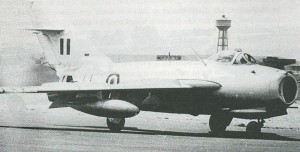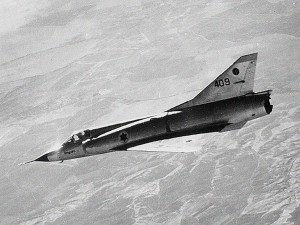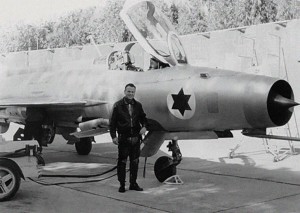Published on April 13, 2015
By Thomas Van Hare
On Sunday, January 19, 1964, an Egyptian flight instructor based at Bilbeis AB in the Nile Delta, walked calmly to his Czech-built Yak-11 training plane. He did his preflight inspection, checked the fuel and tried his best to not appear nervous. He flew quite regularly and the flight would have been a typical morning circuit, however, he had another plan, one he had decided upon a few weeks earlier — he hoped to defect.
The pilot, an Egyptian named Captain Mahmoud Hilmi Abbas Hilmi, was just 26 years old. He was a heavy-built man, described later in news reports as a “husky, swarthy bachelor”. He also loved gambling and had a habit of free-spending with his friends.
Capt. Abbas had risen rapidly through the ranks of the Egyptian Air Force and was an expert fighter pilot. A short while before, he had been deployed with a combat squadron to Yemen where he had flown missions in the hard-fought North Yemen Civil War. Upon his return to Egypt, he had been reassigned as a flight instructor at Bilbeis AB. With the Israel border so close, he decided to take his chances in a dash across the border.
A Cold War Context
A decade earlier in 1954, Egyptian president Gamal Abdel Nasser had assumed power in Egypt. It did not take long for him to turn his country away from the British who had long been the overlords and masters of Egypt. As a counterbalance, Nasser had accepted the Soviet Union’s outstretched hand, what was at the time a stunning development in the Cold War spread of Soviet influence into North Africa and the Middle East.
Almost a decade earlier Egypt had taken delivery of new MiG-17F jet fighters from the Soviets. In fact, even as early as the 1956 Suez Crisis, the EAF had already gone “all Soviet”. It was equipped with MiG-15 and MiG-17F fighter planes, Il-28 bombers, and Mi-1 helicopters, as well as Yak-11s and Zlin 226s for training.
Capt. Abbas, a MiG pilot, had been reassigned to the mission of providing basic flight training to a new generation of Egyptian pilots. As a military officer and pilot, Capt. Abbas was seen as one of the highest, most elite members of Egyptian society at the time. Like the other pilots in the new Egyptian Air Force, he enjoyed respect and privilege that few others could claim.
It is assumed, though few know for sure his real reasons, that Capt. Abbas rejected the pro-Soviet leanings of Nasser’s new Egypt. Perhaps he also objected to Nasser’s iron hand approach to managing domestic politics from Cairo.
The Flight to Israel
For the defection, Capt. Abbas would fly a Czech-built Yak-11 trainer. The Yak, like many of its type, had been sent to the United Arab Republic of Egypt on the order of the Soviet Union, reflecting Moscow’s increasing political and military profile and influence. The Yak-11 wasn’t fast — in fact, its top speed in level flight was around 400 kts with a normal cruise speed of around 260 kts.
Capt. Abbas knew too that his flight would be tracked by Egyptian radar. He knew also that there would be a slight delay in ordering a pursuit once the Egyptian Air Force realized he was defecting. If the delay was long enough, he reasoned that he could make it. The Israeli border was close by and it would be possible to make it before any pursuing planes caught up with him. Nonetheless, it was a real risk. He knew too that the Egyptian Air Force would order jet fighters into the air after him and if they caught him, he would stand little chance of surviving.
Once he took off, he made his fateful turn eastward and sped toward the Israeli border. Flying low and as fast as he could, he took a direct heading for Basr Airbase, an IAF base in the Negev desert that was just across the border within Israel (previously known as RAF Qastina and later renamed by the IAF as Hatzor AB). What he didn’t know was that the Egyptian Air Force had indeed set out in pursuit — but not from one of its bases closer to Cairo or along the Nile River. Instead, a pair of Soviet-built MiG-17s were ordered into the air from El Arish Air Base, directly adjacent to the Israeli border on the northeast tip of the Sinai. Starting from there, it would be no problem catching him before he crossed the border.

Once aloft, the two MiG-17s accelerated rapidly to cut Capt. Abbas off before he reached the border. The two jet fighters had a much greater top speed than the lowly propeller-driven Yak trainer could ever hope to muster. Coming from the north on a heading that took them down the west side of the Egypt-Israel border, it wasn’t long before they spotted him.
Initially, Capt. Abbas thought that they intended to shoot him down, but from their actions, he soon realized that they thought he was a cadet pilot on a practice flight who had perhaps inadvertently gotten lost. As they tried to signal him, he used the time to press onward toward the Israeli border, ignoring the two MiG-17s.
Capt. Abbas also reasoned that once he reached the border, they would undoubtedly shoot him down to prevent the international embarrassment that would transpire if the Israelis captured an Egyptian military flight student. Egypt’s air force would be the laughing stock as one of its pilots had gotten lost and landed in Israel. This was a quandary he had not considered. There was no chance of shaking off the MiGs nor outrunning them as they flew wide circles around him. He trundled eastward steadily toward the border, waiting for what he felt would be inevitable — that at some point they would curve in and shoot him out of the skies.
Incredibly, it was the Israeli Air Force that came to his rescue.
The IAF Response
On the Israeli side of the border, the launch of the two Egyptian MiG-17s from El Arish Air Base raised alarms in the IAF’s air defense headquarters. Given the small size of Israel and its close proximity to Egypt, the IAF was always on a hair-trigger alert. Egyptian fighter jets based at El Arish — if they slipped through — could be over Tel Aviv in a matter of minutes.

With the Egyptian MiGs tracked on radar, a pair of Israel Mirage IIICJs were scrambled to intercept. As the Egyptians flew toward the border trying to signal Capt. Abbas’s plane, suddenly they spotted the two IAF fighters closing in from the east. To avoid an engagement that they might lose, the Egyptian MiGs broke off and turned westward, leaving the Yak-11 to proceed unhindered toward the border. Probably, they hoped that the man who they assumed was an Egyptian flight cadet would see the IAF fighters and turn away as well. Watching the Egyptian MiGs turn away, the IAF too chose to avoid a confrontation. The two Mirage IIICJs took up patrol along the border in a show of force.
This incredibly timely stand-off opened the door for Capt. Abbas to complete his defection. Miraculously unscathed, his lone Yak-11 was watched as it raced across the border and headed for Basr Airbase. The IAF pilots recognized that the plane carried no bombs and that the type wasn’t fitted with guns. They chose to monitor his approach rather than shoot him down. His landing was perfect and he taxied off the runway, relieved to have survived. Once clear, he shut down the engine. Almost instantly, his plane was surrounded by Israeli soldiers.
After Landing
Sitting in the Yak trainer, Capt. Abbas looked around at the assembled group of armed Israeli soldiers surrounding his plane. Slowly and calmly, he climbed out of the cockpit, making sure to make no fast moves. He greeted the Israelis with the words, “I want to give myself up.” Other sources state that he added, “I came here of my own accord, I want political asylum.”
The Israelis quickly accepted that he was defecting from Egypt and, in a huge windfall, they soon also found that he was fully willing to discuss his experiences in the Egyptian Air Force. The base commander at Basr AB, then Col. Moshe Peled, handled Capt. Abbas with great care and turned Capt. Abbas over to the Mossad for intelligence debriefings. Willingly, Capt. Abbas traded his information and knowledge for a chance at asylum — and in so doing, he helped map out the Egyptian Air Force’s organizational chart and he provided details of the personalities of the leaders he knew as well as their daily routines, schedules, and more.
The information he provided turned out to be a major boon to the Mossad, whose understanding of Egypt’s role in Yemen grew extensively. Based on Capt. Abbas’s debriefings, the Mossad concluded that Egypt was over-committed in Yemen, a fact that left it vulnerable to air attack. This critically important piece of information played directly into the planning for the Six Day War that took place just five years later in 1967 (after the Six Day War, Nasser would conclude the same thing and withdrew much of his deployed air forces back to Egypt).
Capt. Abbas’ defection did not go unnoticed, nor did the Israelis make efforts to hide the fact that the Egyptian pilot had willingly defected. Multiple press conferences were held over the following few months. In front of the microphones, Capt. Abbas proclaimed that he had wanted to defect for political reasons and hoped to find asylum, if not in Israel, then in another neutral, non-Arab country. When asked why didn’t defect to an Arab country, he simply stated, “I had two possibilities, an Arab country or Israel. The Arab countries are unstable, therefore I chose Israel.”
He was also asked about the specific political reasons that drove him to defect, but initially, he refused to elaborate. Two months later, he finally was willing to discuss the topic — and he stated that he defected because of objections to Egypt’s participation in the war in Yemen. He went on to disclose Egypt’s use of chemical weapons (poison gas) against the Yemeni royalist partisans of the Mutawakkilite Kingdom, putting Egypt squarely in the cross-hairs of charges of war crimes.
An objection to war does not typically lead to defection, however, leaving us to wonder what additional factors played in his decision. It is possible that his decision was shaped in part too by his relationship with the Egyptian monarchy as part of the extended family of the previous Prince-Regent of Egypt, Abdel Moneim Abbas Hilmi, who ruled from 1952 to 1953 just prior to Nasser’s accession to power.
Finally, when asked about his miraculous escape from the pursuing Egyptian MiGs, who had not shot him down at the border, Capt. Abbas quipped, “They thought I was a cadet who lost his way.”
Egyptian Reaction
Capt. Abbas’s flight was the first time any Arab pilot had defected to Israel, a country that was widely hated in the Arab world. The very thought that a pilot, one of the elites of Egyptian society, could defect to a “better place” in the enemy country of Israel, was anathema to the Arabs.
Forgiveness was not in the cards — nor was honesty. In Cairo, a government radio station broadcast a report that a training plane had gone missing and those search and rescue efforts had not yet been successful. No mention was made of the chase, defection, and press conferences that followed in Israel.
The High Cost of Defection
Sadly, Capt. Abbas was unable to adapt to life in Israel. After some time, he asked the Israeli government to assist him in securing political asylum in Argentina along with a new identity. The Mossad, experts in the field, quickly established a new identity for him. They gave him briefings on personal security as well as a sizable sum of money to ensure that he would be okay once he arrived. The only concern was that he might be found by the Egyptians since, once outside of Israel, he was also beyond their protection. Nonetheless, Capt. Abbas traveled to Buenos Aires on June 20, 1964, to begin his new life.
Right from the start, however, he broke his cover and mailed his mother a postcard to let her know that he was alright and in Argentina. No doubt, the postcard was intercepted and first read by Egyptian authorities. As a result, he did not enjoy his freedom long.
On June 30, 1964, just ten days after his arrival in Argentina, a news item appeared in the Egyptian press (Al-Ahram) claiming that Capt. Abbas had voluntarily walked into the Embassy of Egypt in Buenos Aires and declared his desire to return to Cairo. The story was obviously falsified, however, and few believed it. Everyone knew the fate that awaited him back in Egypt — death, perhaps after torture.
Afterward, investigations by the Mossad revealed how the Egyptians had ensnared Capt. Abbas. While out at night enjoying the city’s famed nightlife, Capt. Abbas had met an Egyptian woman at a nightclub. He was seduced to come back to her apartment on the promise of a good time. However, she turned out to be an Egyptian agent. Instead of enjoying a night with her, on his arrival at her “apartment”, he was kidnapped, tied up, and dragged to the Egyptian embassy. Subsequently, he was taken to Egypt against his will and smuggled out on board an Egyptian cargo ship that happened to be at the port. Once back in Egypt, he faced certain death after a short trial in which he was convicted of treason.
As for the Yak-11, the Israeli Air Force had it on display for a time, though it was never flown. Unlike later jet fighter aircraft that would defect to Israel, a common Czech training plane was of little interest to the IAF. Approximately a decade later, the plane was traded to the British Government for a serviceable North American Harvard training plane, the type that the IAF used for its pilot training before graduating the pilots to high-performance planes and jets.
The ultimate disposition of the Yak that carried Capt. Abbas to Israel is unknown.

One More Bit of Aviation Trivia
Capt. Mahmoud Hilmi Abbas Hilmi’s defection to Israel is not the only one to have taken place in history, though it was the first. In 1966, an Iraqi pilot, Capt. Munir Radfa, also defected, this time on board a Soviet-made MiG-21 jet fighter. Capt. Radfa’s defection had been carefully planned after he had spent four years covertly working with Israel’s Mossad intelligence agency reporting on the Iraqi Air Force’s build-up and modernization programs. The Mossad’s final goal with Capt. Radfa was to have him fly a MiG-21 to Israel where it could be evaluated by the IAF (and subsequently by the USAF as well).
In addition, on August 12, 1968, two MiG-17s of the Syrian Air Force accidentally landed and were captured at Betzet Air Base in Israel. After that, the next MiG to fall into IAF hands came in 1989, when a Syrian pilot, Major Bassam Adel, flew his MiG-23 across the northern border to defect, doing so at 50 feet of altitude at 1,000 mph. Like Capt. Abbas, he survived the journey. His MiG-23 was test flown in Israel by the USAF before ending up in the IAF Museum at Hatzerim AB.

I just came across your magazine. I will be a regular reader from now on. I have been flying since 1959 so I may have some interesting photographs in my stash.
Regards,
Dave
Surely this Yak was the airframe that Doug Bianchi’s Personal Plane Services at Booker secured and flew as G-AYAK?
More likely G-KYAK which was recovered from Israel by Robs Lamplough in 1976.